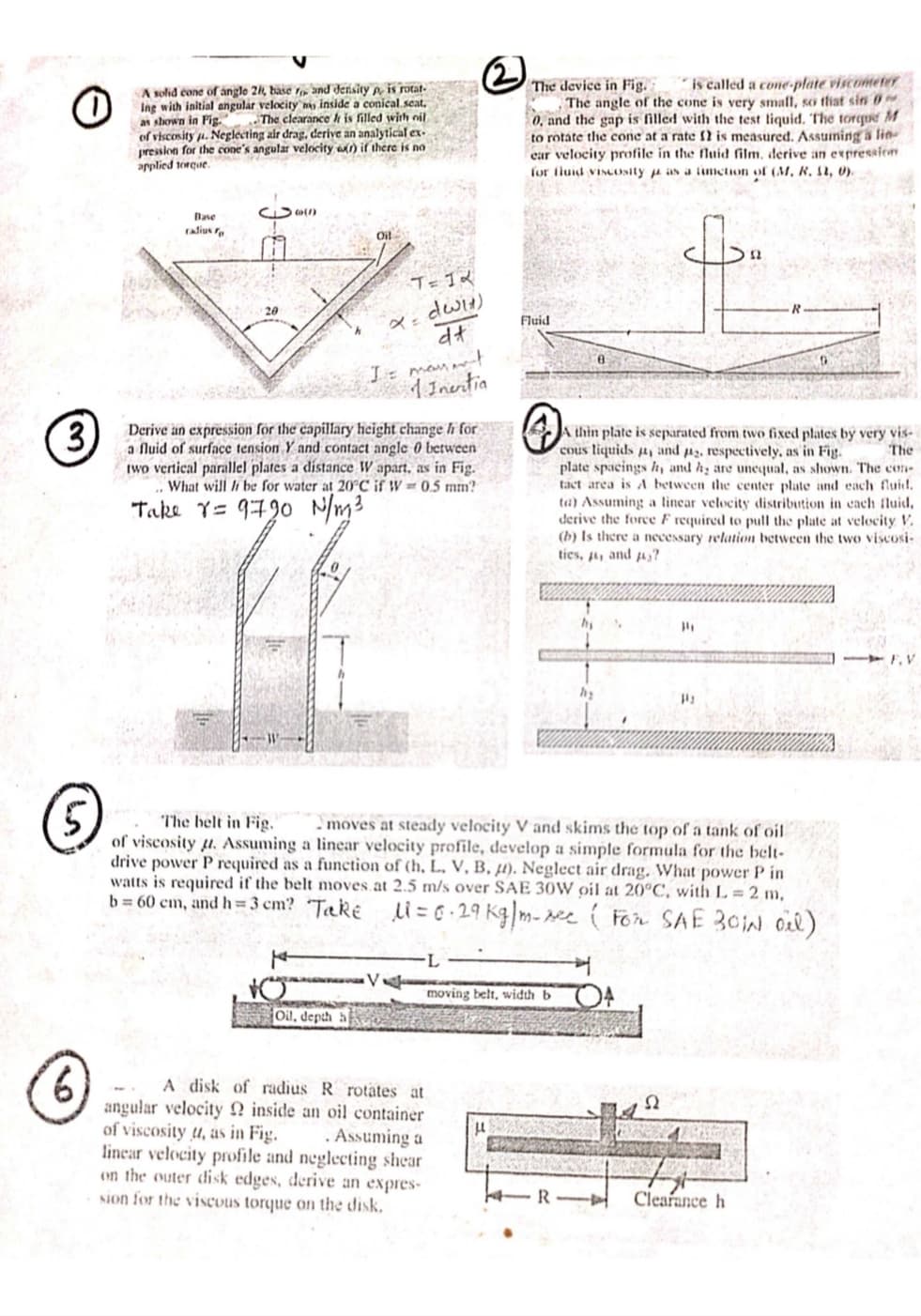A solid cone of angle 24, tase 1,, and denisity p, is rotat- Ing with initial angulár velocity my inside a conical.seat, as shown in Fig. of visconity u. Neglecting air drag, derive an analytical ex- presslon for the cone's angular velocity ) if there is no applied tengue. The clearance h is filled with oil
A solid cone of angle 24, tase 1,, and denisity p, is rotat- Ing with initial angulár velocity my inside a conical.seat, as shown in Fig. of visconity u. Neglecting air drag, derive an analytical ex- presslon for the cone's angular velocity ) if there is no applied tengue. The clearance h is filled with oil
Principles of Heat Transfer (Activate Learning with these NEW titles from Engineering!)
8th Edition
ISBN:9781305387102
Author:Kreith, Frank; Manglik, Raj M.
Publisher:Kreith, Frank; Manglik, Raj M.
Chapter5: Analysis Of Convection Heat Transfer
Section: Chapter Questions
Problem 5.9P: When a sphere falls freely through a homogeneous fluid, it reaches a terminal velocity at which the...
Related questions
Question

Transcribed Image Text:is called a cone-plate viscometer
A solid cone of angle 2k, base 1, and density p, is rotat-
Ing with initial angular velocity my inside a conical.seat,
as shown in Fig.
of viscosity u. Neglecting air drag, derive an analytical ex-
pression for the cone's angular velocity ) if there is no
applied tongue.
The device in Fig.
The angle of the cone is very small, so thiat sin 0
0, and the gap is filled with the test liquid. The torque M
to rotate the cone at a rate 1 is measured. Assuming a lin-
ear velocity profile in the fluid film, derive an expression
for tiuid viscosity u as a tumction of (M, R. S2, 0).
The clearance h is filled with nil
Bave
C co
radius a
dwit)
dt
Fluid
I manmot
1Inentia
Derive an expression for the capillary height change h for
a fluid of surface tension Y and contact angle 0 between
two vertical parallel plates a distance W apart, as in Fig.
. What will li be for water at 20°C if W = 0.5 mm?
A thin plate is separated from two fixed plates by very vis-
cous liquids , and g, respectively, as in Fig.
plate spacings h, and hy are unequal, as shown. The con-
tact area is A between the center plate and each fluid.
ta) Assuming a linear velocity distribution in cach fluid,
derive the force F required to pull the plate at velocity V.
(b) Is there a necessary relation between the two viscosi-
ties, 4, and a,?
The
Take Y= 9790 N/m3
5,
The belt in Fig.
of viscosity u. Assuming a linear velocity profile, develop a simple formula for the belt-
drive power P required as a function of (h, L, V, B, µ). Neglect air drag. What power P in
watts is required if the belt moves.at 2.5 m/s over SAE 30W oil at 20°C, with L = 2 m,
b= 60 cm, and h=3 cm? Take li = 6.29 Kg m- ree í For SAE 30W Ol)
moves at steady velocity V and skims the top of a tank of oil
moving belt, width b O4
Oil, depth a
6)
A disk of radius R rotates at
angular velocity N inside an oil container
of viscosity u, as in Fig.
. Assuming a
lincar velocity profile and neglecting shear
on the outer disk edges, derive an expres-
sion for the viscous torque on the disk,
Clearance h
3,
Expert Solution
This question has been solved!
Explore an expertly crafted, step-by-step solution for a thorough understanding of key concepts.
Step by step
Solved in 2 steps with 1 images

Knowledge Booster
Learn more about
Need a deep-dive on the concept behind this application? Look no further. Learn more about this topic, mechanical-engineering and related others by exploring similar questions and additional content below.Recommended textbooks for you

Principles of Heat Transfer (Activate Learning wi…
Mechanical Engineering
ISBN:
9781305387102
Author:
Kreith, Frank; Manglik, Raj M.
Publisher:
Cengage Learning

Principles of Heat Transfer (Activate Learning wi…
Mechanical Engineering
ISBN:
9781305387102
Author:
Kreith, Frank; Manglik, Raj M.
Publisher:
Cengage Learning